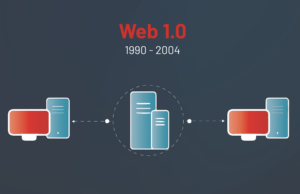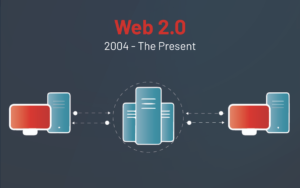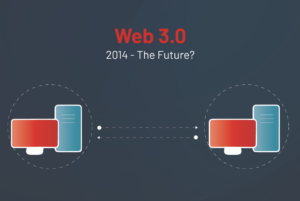The web has undergone evolution to meet the needs of its users. The performance, features, and scale of the internet have seen major reformations in the past. The internet is recently going through another paradigm shift. To remain relevant, it is critical for the end-users and business organizations to stay updated about these changes.
Since its inception, the internet has catered to a niche. The first version of the web catered to technologically advanced developers. The second version is set up for monetization, and the big companies capitalize from it. However, the third version of the web offers, for the first time, the opportunity to own and operate tech platforms. It is posited on the notion of data security and privacy and provides a solution to gaps of web 2.0 that have become apparent now.
For understanding Web 3.0, it is crucial to discuss how the internet has evolved.
The First Version of the Web (1994 – 2004) – Web 1.0
Web 1.0 was the read-only web. The first iteration of the web contained information in basic fonts, hyperlinks, or image format. It offered limited scope of user interaction and user-generated content. It was used by developers to build websites. The data was served from a static file system rather than a database.

The Second Version of the Web (2004 – Present) – Web 2.0
Web 2.0 is more complex than its predecessor. It is the web in its current form, known as the interactive and social web. This version of the web promotes user-generated content. With various apps, users can create content and broadcast it to a large audience.
Web 2.0 is interactive and user-friendly. It was engineered to expand its user base for monetization of the apps. Exemplified by companies like Google and Facebook, that function on the simple idea of more data leading to personalized ads. Consequently, the generation of ad revenue. Data tracking was made possible due to the centralization of user data, owned, and controlled by these platforms.

The Third Version of the Web – Web 3.0
Web 3.0 is the solution to data tracking and the growing privacy concerns about how user information is collected and used on the Internet. It fundamentally rethinks the architecture and its interaction with applications, from a user’s perspective on data security and privacy.
Decentralization is at the core of web 3.0. It means that the applications are not, built or deployed over a single server or managed by a single cloud provider. Web 3 applications either run on blockchains or a decentralized network of servers. Decentralization ensures that the data is not controlled by a single entity.
Web3 enhances the internet as we know it today with a few other added characteristics. Web 3.0 is:
- Verifiable
- Self-governing
- Distributed and Robust
- Stateful
- Native built-in payments
- Access to financial services

What Does Web 3.0 Offer?
- Digital Asset Creation
Web 3.0 allows direct ownership of digital assets through non-fungible tokens (NFTs). With the use of NFT as a currency, you can trade or sell your digital asset in the open market and recoup its value. This feature allows you to make investments and gain maximum profits by trading or selling. It gives you ownership of your digital assets in an unprecedented manner.
- Creator’s Control over the Content and Its Profits
Currently, the host platforms exercise control over executive decisions such as censorship and distribution of profits. Since the content creators use these centralized platforms, they face restrictions over the type of content that can be broadcasted, impacting their creative process. Additionally, the content creators are at a monetary loss since the platforms determine their share of profits. The platform further excludes the creators from the process of updating their rules and policies, which may be exploitative or inconvenient, causing difficulty in seamless operations.
Web 3.0 offers a viable role in decision-making to content creators. It allows them to own the shares of a platform using tokens and become a decision maker on resource allocation, profit sharing, and policy agreements. Web 3.0 further allows creatives to plug their followers into a new interface without losing followers.
- Digital Autonomous Organizations
Digital Autonomous Organizations (DAOs) are decentralized platforms where no single entity is in control. These are run by multiple owners ensuring balance and inclusion. The NFT is used as a currency to own a platform. The process is like buying shares in a company. The ownership in a DAO provides the opportunity to partake in the running of an organization. The pool of owners decides the policies and rules for implementation, the allocation of resources, sharing of profits, and its distribution. Voting is done, and the automated system returns the response.
- Building Start-Ups
Web 3.0 provides exciting avenues for innovators, entrepreneurs, and thinkers. An entity with an innovative idea or project does not have to wait for an investor whose values may or may not align with the project objectives in the future.
Instead, you announce a new project, and anyone can participate in building it or investing in it from day one to enable ownership, participation, and governance. The project owner may retain some shares for relevant stakeholders and the initial developers while releasing other tokens in the open market. The project will attract like-minded people to invest in it and contribute to streamlining the project in a positive direction. It will also allow the relevant stakeholders to use their tokens to vote on changes to the project’s future. The interested parties will retain the ownership, while people who do not see value can sell or trade their tokens. This process will allow the coming together of a dedicated team and dynamic culture of investments.
- Direct Profits
Cryptocurrency is well-embedded into the design of web 3.0. Cryptocurrencies are like money and can transfer actual value digitally without a centralized third party. The currency is leveraged as a financial incentive for its users who want to participate in creating, governing, contributing to, or improving one of the projects themselves. People can participate in providing technical or non-technical services. The payments made by users of these services will go directly to the network participants. Any intermediaries are cut-off, and direct profits are made.



